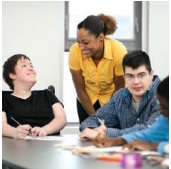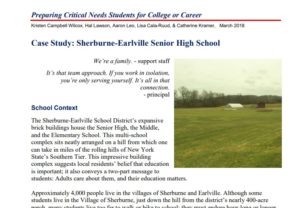Schools as “Undercover” Child Care and Family Support Systems
By Hal A. Lawson and Aaron Leo
The late John Goodlad, internationally acclaimed educational renewal leader, once sparked controversy among members of the Leadership Academy for The National Network for Educational Renewal (NNER) when he made the following claim: “Schools are child care institutions.” After listening to a few protests, he responded: “Close schools without notifying parents in advance, and see what happens!” Discussion immediately shifted to the implications of this essential child care function.
The common law doctrine of in loco parentis (i.e. “in place of the parent”) has sent this same meta-message for over a century. Under this doctrine, parents implicitly delegate to educators selected responsibilities for their children. As educators perform parent-like roles for young people’s socialization, the schools that employ them accept shared legal obligations for students’ care and treatment. In an ideal world, parent-teacher conferences and educators’ home visits facilitate mutually beneficial communication, coordination, and shared efforts in the best interests of the child.
The School-Child Care Connection
During times of societal stability, the social compact between parents and educators tends to run on a kind of “autopilot,” and educators’ heroic deeds often remain unnoticed by the general public and even the school’s parent-teacher associations. For example, caring teachers and student support professionals use their personal funds to purchase school supplies for needy children. They obtain and purchase food and place it in student backpacks every Friday, enabling the children in their care to have something to eat over the weekend. They work behind the scenes with social workers responsible for foster care students.
At the same time, the school’s cafeteria staff assumes parental responsibilities when they prepare and offer school lunches, breakfast programs, and afterschool snacks. Bus drivers monitor appropriate behavior and discipline young people who are out of order, and they also assume responsibility for ensuring safe transport from home to school and back again. Custodians, secretaries, and school safety guards routinely befriend and mentor students. And all school staff remain on the look-out for indicators of child abuse and neglect—an unpleasant but essential responsibility for which educators share accountability.
Schools, thus, are important, essential child care institutions. And when educators form solid relationships with parents, entire families are supported. For example, employed parents know the whereabouts of their children and are spared the expenses and occasional hassles of securing child care. Parents without jobs gain discretionary time. Every parent gains child rearing assistance and supports from educators acting in loco parentis.
The shocks accompanying COVID-19 serve to illuminate all such taken-for-granted features. Clearly, schools are child care institutions. While they offer social supports and resources to all parents/caregivers, parents with jobs are special beneficiaries who may be tempted to take educators’ child care responsibilities for granted and forget to say “thank you.”
Today’s challenging times provide opportunities to strengthen relationships between parents and educators. For example, parents forced to make choices between employment responsibilities and child care come to appreciate anew all that educators and schools have provided for their families. Meanwhile, educators tasked with distance-delivered learning and instruction gain opportunities to craft effective strategies to communicate and partner with parents. The reminder here is that both sets of actors—parents and educators, particularly teachers—are experiencing considerable stress and need to work together.
Crises such as COVID-19 offer opportunities to investigate, reflect, learn, improve, and innovate in the area of family-school-community relations. Examples of how families, schools and communities can respond to crises follow.
AFDC, TANF, and 21st Century Learning Centers
The first example concerns vulnerable families—families whose household incomes are just above, at, or below the federal poverty line. Considerable numbers of them are single-parent households headed by mothers who often shoulder weighty responsibilities. If they receive public financial assistance, it tends to be time/term-limited. Essentially, federal policy requires a choice between being at home with one’s children or working.
Welfare reform, as it was known in 1996, remains important to educators. Essentially, it marked a shift from Aid to Families with Dependent Children (AFDC) to Temporary Assistance to Needy Families (TANF). Whereas AFDC was predicated on the idea that maternal care was an essential safeguard for children’s well-being and thus legislated continuous fiscal supplements, TANF was launched with a different set of assumptions. TANF assumed that children benefited when their parents were employed. Public assistance, formerly long-term, became time/term limited (i.e., assistance was temporary). Unemployed parents had an eighteen-month clock running in their heads as they pursued employment. Parental stress often became family stress, with impacts on school-aged children and youth.
The Clinton Administration and Congress crafted a boundary-bridging response plan that had educators and schools as centerpieces. They called for and supported the development of 21st Century Learning Centers. Whether offered by schools, community agencies, or both, these innovations were designed to support employed parents; contribute to healthy child development, while preventing crime and delinquency; and enhance student success and school improvement via extended, expanded, and accelerated learning supports during the non-school hours.
Many of today’s Community Schools “morphed” from these Centers. All prioritize and improve new working relationships among educators, children, parents, and entire families. The crisis provided the opportunity!
Schools as “Under Cover” Bridges for Child Care and Family Support
In many schools, “parent involvement” refers to a one-way street in which parents are expected to play a few clearly defined support roles, such as assisting with school-sponsored activities such as field trips, volunteering in the classroom, or leading fund-raising activities for a school function. This model fails to communicate all that educators do to help children, assist their parents, and support families.
Fortunately, a growing number of educators and their community partners are organizing and mobilizing for collective action to augment child care, support parents, and strengthen families–particularly diverse and vulnerable ones. In fact, some schools employ parents and charge them with recruiting and working with others. Some such school-employed parents serve as “cultural brokers,” connecting with culturally diverse families, especially those whose first language is not English. Put differently, relationships between schools and families are facilitated when schools employ representative parents and community leaders as bridge-builders.
All such educator-initiated and school-sponsored parent and family initiatives complement conventional parent involvement initiatives. Most of all, they announce to all what educators and schools already prioritize and do in service of child care and family support—albeit “under cover.” And they provide educators with parental knowledge, assistance, and resources, particularly for students and families characterized as “hard to reach” and “difficult to serve.”
If it is safe to assume that the COVID-19 crisis is yet another instance of the challenges associated with identifiable sub-populations of students and families, then it’s also an opportune time to explore all that educators and their schools can do to improve their relationships with parents and families as both engage in crucial child care responsibilities. The dominant parent involvement/PTA model is a good place to start, but it’s a long way from the desired destination. Parents can help in the development and continuous improvement of what amounts to a two-way street between educators and parents, enhancing child development, supporting families, and strengthening schools.
An Example from a NYKids Positive Outlier School
Research conducted at schools investigated by NYKids’ research teams offers additional evidence of the ways in which schools can provide essential childcare functions and family support.
Educators at Sherburne-Earlville have taken steps to support students and their families during past economic and social hardships experienced in the community. Recognizing the emergent needs of families in poverty, educators first ensured that their students’ “basic needs” were met by providing them with food, clothing, and other necessities such as hygiene products.
Additionally, as school and district leaders recognized the growing mental health needs of students, they prioritized the hiring of additional school counselors and social workers. As the principal of Sherburne-Earlville put it, “You’re trying to meet the needs of the whole family and not just the student.”
More information about NYKids positive outlier schools and their efforts to bridge divides between schools and families can be found in our case studies on Sherburne-Earlville and Freeport, as well as in a recently published article in the School Community Journal.
A Final Note
John Goodlad founded NNER because he was concerned that the primary purpose of our schools and education system was at risk of being compromised and even lost from view. The primary purpose, in his and other leaders’ view, was and continues to be preparation for citizenship in our precious democracy. Put another way, democracy and education depend on each other.
In retrospect, he should have added a third component: Families. They influence and co-determine the developmental and life course trajectories of children and youth in New York as well as the nation—today’s and tomorrow’s students. This implies special roles and responsibilities for educators and schools, and it necessitates strategies other than inherited parent involvement with its one-way relationship.
Already committed, child-oriented and family-supportive educators are providing leadership, and some are paying for it out of their own pockets. These pioneers signal the way ahead during our turbulent times, and they necessitate responsive and proactive changes in preservice education and educational policy. If NYKids’ research and blogs like this one facilitate these important developments, they have achieved a primary aim.




